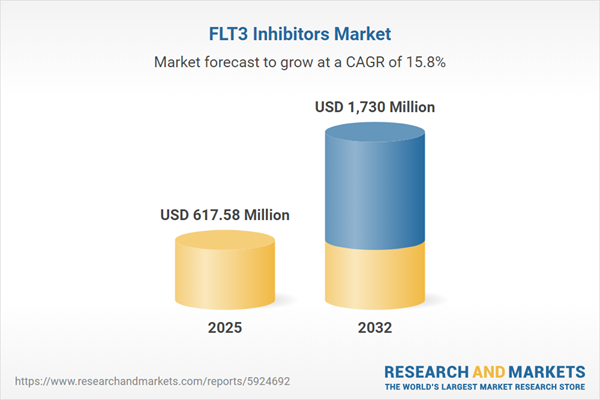Speak directly to the analyst to clarify any post sales queries you may have.
The FLT3 inhibitors market is undergoing active transformation as regulatory requirements and clinical practices evolve across hematologic oncology. Senior leaders require targeted, actionable insights to confidently steer business strategies amid mounting complexity and shifting industry standards.
Market Snapshot: FLT3 Inhibitors Market Trends and Dynamics
The FLT3 inhibitors market is expanding rapidly, with a compound annual growth rate of nearly sixteen percent. This growth is propelled by advancements in molecular targeting technologies and a sustained industry commitment to precision oncology initiatives. As targeted therapies become foundational in the management of hematologic malignancies such as acute myeloid leukemia, stakeholders are reconfiguring operational models and forming new alliances to optimize clinical integration. Adaptation to evolving regulatory standards not only strengthens compliance but also expands access to emerging therapies, ultimately enhancing patient outcomes and driving sector-wide innovation.
Scope & Segmentation of the FLT3 Inhibitors Market
This report outlines a comprehensive executive framework to inform effective decision-making and strategy in the FLT3 inhibitors sector. Key segmentation elements and areas of focus include:
- Indication: Captures developments in acute myeloid leukemia treatment pathways, with consideration for both new and relapsed patient cohorts, highlighting the impact on clinical workflows and adoption trends.
- Generation: Reviews first- and next-generation FLT3 inhibitors, emphasizing their ability to address resistance mechanisms and facilitate advances in personalized medicine strategies.
- Molecule Type: Details both Type I and Type II inhibitor classes, analyzing their significance across distinct patient populations and therapeutic contexts.
- Route of Administration: Considers oral and intravenous delivery options, underscoring flexibility for inpatient, outpatient, and home-based care implementation.
- Distribution Channel: Assesses avenues such as hospital, retail, and online pharmacies, examining emerging digital trends and patient access implications within expanding healthcare models.
- End User: Explores utilization patterns across hospitals, specialized centers, and home-care settings, reflecting the sector's gradual shift toward decentralized and accessible care delivery.
- Region: Analyzes core markets including North America, Latin America, Europe, the Middle East and Africa, and Asia-Pacific, taking into account the influence of regional policy frameworks and reimbursement structures.
- Key Technology and Players: Highlights core technologies such as high-throughput screening and molecular profiling, and profiles major companies—Astellas Pharma Inc., Novartis AG, Daiichi Sankyo Company, Limited, Arog Pharmaceuticals, Inc., and Pfizer Inc.—to provide benchmarks for strategy and competitive analysis.
Key Takeaways for Senior Decision-Makers
- Molecular engineering advances now support more responsive patient selection, allowing for strategic deployment of FLT3 inhibitor therapies tailored to diverse clinical needs.
- Innovation in drug development is facilitating expanded options for both treatment-naïve and relapsed patients, guiding effective portfolio management and risk-reduction initiatives.
- Enhanced collaboration between pharmaceutical developers and diagnostics providers is accelerating the rollout of companion diagnostics and facilitating streamlined regulatory pathways.
- Growth in digital and retail pharmacy distribution channels is broadening patient access, reinforcing a pivot toward patient-centered healthcare delivery models.
- Integration of real-world data and patient-reported outcomes is refining payer negotiations and advancing progression toward sustainable, value-based reimbursement models.
- Organizations with agile regional operations remain better positioned to anticipate policy and reimbursement changes, maintaining resilience in a dynamic market environment.
Tariff Impact on Supply Chain and Research
Current U.S. tariff policies are impacting sourcing and manufacturing strategies for active pharmaceutical ingredients in FLT3 inhibitors. Companies are proactively enhancing supplier network diversity, increasing domestic procurement, and strengthening coordination with regulatory authorities. These adaptive measures are designed to protect research continuity and safeguard clinical development timelines amid fluctuating trade environments.
Methodology & Data Sources
This analysis is built on a rigorous multidisciplinary review, drawing from peer-reviewed scientific publications, clinical trial data, regulatory submissions, and expert perspectives from the fields of hematology, oncology, supply chain, and health policy. This approach ensures recommendations reflect both scientific rigor and real-world market dynamics.
FLT3 Inhibitors Market: Why This Report Matters
- Enables senior leaders to navigate shifting clinical and regulatory landscapes in the FLT3 inhibitors market with up-to-date, targeted business intelligence.
- Supports confident adoption of innovative therapies and supply strategies by providing granular analysis of key market segments, technological advances, and competitive benchmarks.
- Empowers region-specific decision-making to elevate product launch effectiveness and optimize market entry approaches.
Conclusion
This report equips executives with the essential insights and analysis needed to shape forward-looking strategies, maintain growth, and respond effectively to evolving sector trends in the FLT3 inhibitors market.
Additional Product Information:
- Purchase of this report includes 1 year online access with quarterly updates.
- This report can be updated on request. Please contact our Customer Experience team using the Ask a Question widget on our website.
Table of Contents
3. Executive Summary
4. Market Overview
7. Cumulative Impact of Artificial Intelligence 2025
Companies Mentioned
The companies profiled in this FLT3 Inhibitors market report include:- Astellas Pharma Inc.
- Novartis AG
- Daiichi Sankyo Company, Limited
- Arog Pharmaceuticals, Inc.
- Pfizer Inc.
Table Information
| Report Attribute | Details |
|---|---|
| No. of Pages | 196 |
| Published | November 2025 |
| Forecast Period | 2025 - 2032 |
| Estimated Market Value ( USD | $ 617.58 Million |
| Forecasted Market Value ( USD | $ 1730 Million |
| Compound Annual Growth Rate | 15.8% |
| Regions Covered | Global |
| No. of Companies Mentioned | 6 |









